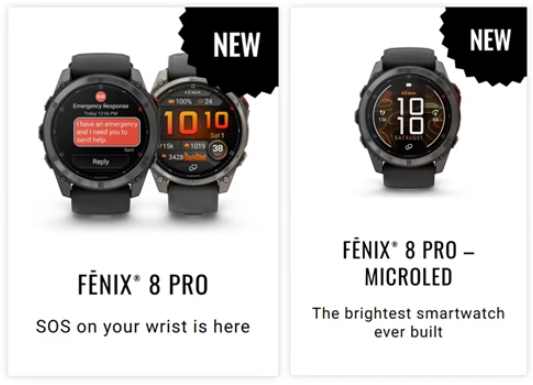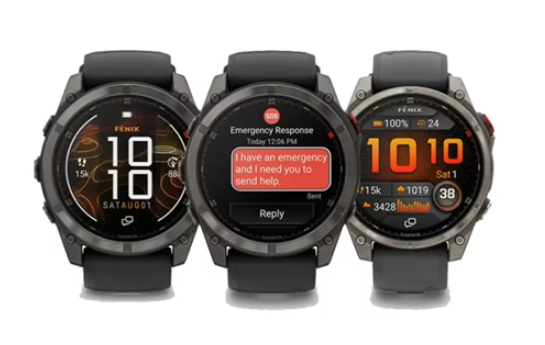11
2025
-
09
Garmin's first MicroLED smartwatch is set to launch soon.
On September 2, foreign tech media outlet Garmin Rumors reported that Garmin’s smartwatches—the Fenix 8 Pro and the Fenix 8 Pro Micro LED—have appeared on the brand’s official website, hinting that they could be unveiled later this month.

Image source: Garmin
In fact, as early as last September, Garmin had already showcased its Fenix 8 Pro Micro LED smartwatch product within its mobile app. Earlier, relevant media reported that AU Optronics had begun supplying Micro LED panels to Garmin for its smartwatches starting in the first quarter of 2025.
Reportedly, the Fenix series is designed specifically for outdoor sports and adventure enthusiasts, offering a range of features such as GPS positioning, health monitoring, and enhanced environmental adaptability. The Pro version of the Fenix series boasts improved sensor accuracy, longer battery life, and premium material design. Meanwhile, the company has officially announced that the upcoming Fenix 8 Pro Micro LED model will not only feature even better specifications but will also become the brightest smartwatch on the market.
The Fenix 8 Pro Micro LED watch is expected to be available exclusively in a larger 51mm size. As for pricing, the current AMOLED version of the Fenix 8 in the 51mm model retails for around $1,200, leading industry media to predict that the Micro LED version will likely cost more than $1,200—possibly even approaching $2,000.

Image source: Garmin
Micro LED boasts clear advantages, but its adoption in watch applications will still take time.
With Garmin's upcoming launch of its Micro LED watch, Micro LED technology is poised for another wave of innovation, simultaneously driving a fresh upgrade in smartwatch technology.
Looking back at the evolution of smartwatches, this product has consistently aimed for longer battery life, richer features, and superior display performance. From the initial LCD screens to today's mainstream AMOLED displays, each iteration in display technology has significantly enhanced the user experience. However, AMOLED still faces inherent limitations when it comes to visibility under bright outdoor conditions, peak brightness levels, and the risk of "burn-in" over extended use.
The emergence of Micro LED technology offers a perfect solution to these challenges. As a self-emissive technology, it shrinks traditional LEDs down to the micrometer level, enabling each pixel to emit light independently. Compared to AMOLED, Micro LED delivers higher brightness, lower power consumption, superior resolution, and exceptional contrast ratios—making it poised to become a strong contender against AMOLED technology in future smartwatch applications.
Thanks to its outstanding technological advantages, Micro LED has attracted several companies to enter the field and develop related Micro LED smartwatch products. However, looking back now, the development of Micro LED smartwatches hasn’t been entirely smooth.
Before Garmin, tech giant Apple launched its in-house Micro LED project, codenamed "T159," a decade ago, aiming to equip its Apple Watch Ultra with a custom-built Micro LED display.
However, after investing billions of dollars and forging deep partnerships with suppliers like ams OSRAM, Apple paused the project in early 2024. The primary reasons were the prohibitively high production costs of Micro LED technology and the persistent challenges in achieving breakthroughs in the complex mass-transfer process, making it impossible to ramp up mass production within the targeted cost and timeline. At the time, Apple’s decision to halt the Micro LED watch project sent significant ripples through the entire industry.
Unlike Apple, which is focused on large-scale mass production, the Swiss luxury watch brand TAG Heuer views Micro LED as a testing ground to enhance its brand’s technological sophistication and luxurious experience. In the fourth quarter of 2023, AU Optronics began shipping the first batch of Micro LED panels to TAG Heuer. By 2024, industry reports indicated that TAG Heuer had already achieved mass production of its Micro LED smartwatch—but the product’s official launch date remains undisclosed at this time.
Therefore, Garmin’s Fenix 8 Pro Micro LED series is poised to become the first officially launched Micro LED watch, marking a crucial step in the early adoption and development of Micro LED technology for wearable devices.
The upstream panel industry chain is actively deploying Micro LED solutions for watch displays.
Although the application of Micro LED watches is still in its early stages, the upstream panel industry chain is already actively researching relevant technological solutions and working to accelerate the development of Micro LED watch technology while driving down costs.
For instance, AU Optronics has already begun mass production of Micro LED watch panels as of the end of 2023. Meanwhile, AU Optronics’ Gen-4.5 Micro LED production line is set to ramp up manufacturing of smartwatches, large-screen TVs, and other products in 2025, with plans to expand into automotive displays by 2026.
Earlier this year, Samsung Display showcased a Micro LED smartwatch screen with a brightness of 4,000 nits. Then, in August, Samsung Display further boosted this figure to 6,000 nits by improving the luminous efficiency. The display boasts a resolution of 326 PPI and features approximately 700,000 ultra-small, three-color LED chips.

Image source: Samsung Display
NuoChuang Technology also launched a 1.39-inch Micro LED smartwatch panel this year, featuring efficient, energy-saving Tantium chip technology and delivering high resolution with a peak brightness of 5,000 nits—providing wearables with a new solution that balances power efficiency and superior image quality.
Innolux Display has already developed a 1.1-inch Micro LED wearable display with 338 PPI, featuring ultra-high pixel density, exceptional resolution, and low power consumption. Mass production is expected to begin in 2025.
Summary
Although Apple has paused its Micro LED watch project, the Micro LED watch market still holds significant potential. Meanwhile, other leading consumer brands are already pioneering the integration of Micro LED technology into their premium product lines, catering to the growing demand in the high-end market.
Meanwhile, panel manufacturers are actively advancing the development of Micro LED watch application solutions, aiming to further drive the growth of Micro LED technology while simultaneously enhancing the performance of smartwatches.
Although it will still take time, it’s clear that after applications in LED displays, AR glasses, and in-vehicle displays, Micro LED technology has the potential to unlock its full potential in the smartwatch market, further driving the overall growth of the Micro LED market.


